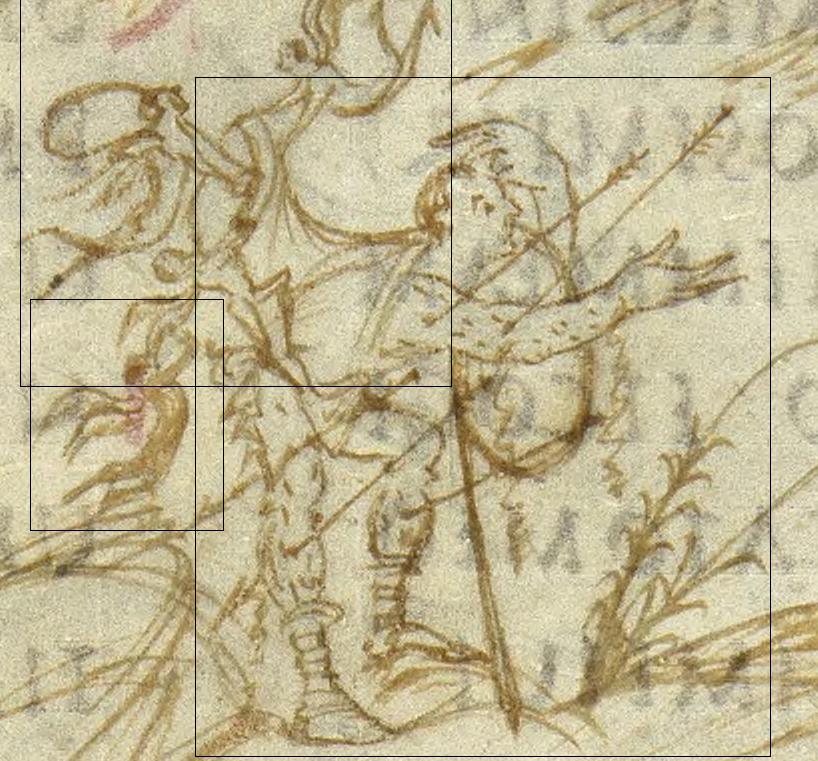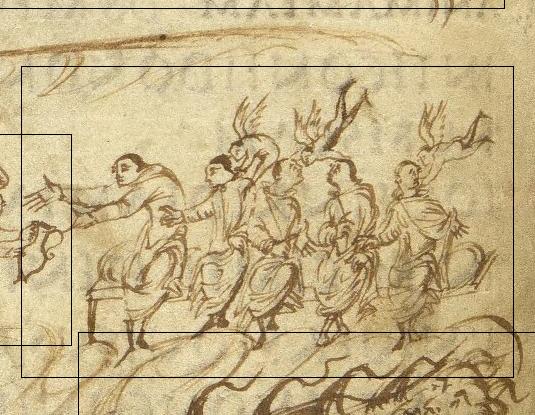Winged Ninth-Century Elves?! August 19, 2017
Author: Beach Combing | in : Medieval , trackback
Beach has previously interested himself with winged fairies and today he came across this very early image from the Utrecht Psalter. The Utrecht Psalter was almost certainly created in northern France in the ninth century and has fabulous line drawings that will bring you as close as you will ever come to the early Middle Ages: Beach likes to think of it as Dark Age neorealism. A claim has been made for winged elves in psalm 37 and Beach went to an excellent digital copy and got a screen capture for general discussion. It was Brian Branston, in fact, who suggested, in 1957, that we see here an elf-shot man surrounded by flying elves. The great Katharine Briggs (1967) disagreed and said that these were, instead, demons or illusions (the latter described in the psalm: ‘Quoniam lumbi mei impleti sunt illusionibus: et non est sanitas in carne mea’). She also claimed that the ‘elves’ looked like the angels elsewhere in the psalter. Beach includes another image of angels, and he is not convinced.

A couple of thoughts. There is no reason for thinking that this is an elf-shot man, as opposed to a man with arrows in him: it would be interesting to see if we could find other proof for elf-shot beliefs in northern Gaul. As to the ‘elves’ these are almost certainly winged demons. The clincher here is the illustration for psalm 25 in the Utrecht Psalter that shows nasty devils whispering evil into the ears of their prey. Though note these demons seem a bit chubbier? Perhaps it is just because they are drawn slightly larger. Contrary views: drbeachcombing AT yahoo DOT com
Why are demons winged? Because, of course, they were originally angels (before the rebellion): and angels are winged in early medieval art.

Still fabulous illustrations. Beach would recommend you visit the online psalter and luxuriate there for an hour. The magnify function is extremely efficient and navigation is smooth. Text and commentary on the left.
Bruce T, 29 Aug 2017: At least that’s what those demonic winged creatures are lifting the man’s cloak to give whatever is firing those arrows from above a clean shot at. If you’ve noticed, and I’m sure you, have you tricky fellow, the angels in those drawings you put up are cloaked, while our demonic winged creatures are nude. The chubbiness in the bottom drawing I agree is likely because they had more room to use for the illustration. However, the men being tempted in that drawing seem to be monks while the man in the first seems to be a regular shepherd or cowherd. Perhaps Satan sent in the first team to deal with the monks, and let the second team cut their teeth on the more devout locals? There were martyr stories of death by arrows from the era of persecution of Christians in the Roman Empire along with likely extant murals in the great houses, stone fortresses( like Utrecht), and palaces that the Germanic elite took over as seats during and after the collapse in the West. There would have been both cherubs and Cupid with his bow in the still remaining murals and illustrations from the pagan era throughout Western Europe in the era the Psalter was created in. The artist of the Psalter would have had many partial and full murals and illustrations of such at this time to draw from. No elves here. Just damnable, demonic, pagan cherubs running amok in the Netherlands.
Leif writes, 29 Sep 2017: You mention a Brian Branston, who suggested, that we see an elf-shot man surrounded by flying elves. It would be interesting to see Mr. Branston’s supporting evidence. Alaric Hall, writing as a doctoral candidate in 2004, raises an argument which– if correct– throws a monkey wrench into Mr. Branston’s assertation. Examining ‘Bald’s Leechbook’, an Anglo-Saxon medical text written in the mid tenth century at latest, Alaric argues that by that time the term ‘elf-shot’ had a specific medical meaning– along the line of ‘shooting pains’. If he his correct, an Anglo-Saxon physician would not have associated an elf-shot with an elf any more than a modern oncologist would associate a cancer with a crab. (I’ve included the relevant quote at the end of this comment, to do Dr. Hall full justice.) Moreover, the illustrations in the ‘Utrect Psalter’ appear to represent the scripture quite literally, at least to this commenter’s causual eye. For Psalm 11, verse 7: ‘The words of the Lord are pure words: as silver tried by the fire, purged from the earth, refined seven times,’ the artist has drawn smiths at a smelter. For Psalm 17, verse 34: ‘Who hath made my feet like the feet of harts: and who setteth me upon high places,’ the artist has drawn a harts on a mountain top. For Psalm 39, verse 10: ‘I have declared thy justice in a great church,’ the artist has drawn (guess what?) a great church. And so on. Since Psalm 37 is a prayer to the Lord which in verse 3 reads: ‘For thy arrows are fastened in me: and thy hand hath been strong upon me.’ it seems reasonable to conclude the arrows come as divine retribution. Quote follows: Alaric Hall. The Meanings of Elf and Elves in Medieval England. Dissertation, Department of English Language, University of Glasgow. 2004. p 109. “Thun, stating what other scholars imply, deduced that ‘the mention of ylfa makes it seem likely that the elves were thought to be those who were shooting’ (1969, 385). This inference is predicated on the idea that ‘of sceotan’ connotes the shooting of missiles, for which we must posit a source. However, although ‘sceotan’ literally denotes thrusting or shooting, later in English it had specific medical meanings along the lines of ‘to afflict, cause pain; have darting pains’…


